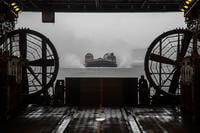China released its new National Defense White Paper this week, which can be found here on the People’s Daily Online. The paper says China’s defense expenditures are both “reasonable and appropriate," and puts that figure at 1.38 percent of China’s GDP in 2007 (the CIA puts that figure at closer to four or five percent). “Although the share of China's defense expenditure in its GDP increased, that in the state financial expenditure continued to drop on the whole," it says. The paper says defense spending increases are needed to (1) increase salaries and benefits of personnel; (2) compensate for commodity price rises, such as food and fuel; and (3) push military modernization.
The paper states that, “China has become an important member of the international system, and the future and destiny of China have been increasingly closely connected with the international community. China cannot develop in isolation from the rest of the world, nor can the world enjoy prosperity and stability without China.”
Here is Stratfor's take:
“While the White Paper is not directly threatening a more aggressive and confrontational Chinese military, it does suggest that the capabilities for a cooperative PLA are equally applicable to a confrontational one, should the global system evolve in the “wrong” direction. Coming as it did on the day of Obama’s inauguration, the paper is clearly part of a Chinese strategy to shape the new U.S. administration’s views on China from the start. And the message is clear: “The world [cannot] enjoy prosperity and stability without China.””
The paper doesn’t present a particularly sophisticated view of global developments, reading in places like a Thomas Friedman column. The paper says the world is becoming increasingly interconnected and that common economic and political interests tie nations together “thereby keeping low the risk of worldwide, all-out and large-scale wars for a relatively long period of time.” The paper seeks to allay fears of rising Chinese power: “China will never seek hegemony or engage in military expansion now or in the future, no matter how developed it becomes.”
The paper highlights China’s increased participation in “Military Operations Other Than War,” including UN peacekeeping operations with 1,949 Chinese personnel serving in nine UN mission areas that include Congo, Liberia, Sudan and East Timor. The paper says the PLA has stepped up military exercises and exchanges with other nations.
As for that one scenario upon which defense analysts hang a potential U.S.-China war:
“The attempts of the separatist forces for "Taiwan independence" to seek "de jure Taiwan independence" have been thwarted, and the situation across the Taiwan Straits has taken a significantly positive turn. The two sides have resumed and made progress in consultations on the common political basis of the "1992 Consensus," and consequently cross-Straits relations have improved.”
The Chinese appear to be as concerned with internal as with external threats. The paper says China faces “disruption and sabotage” from “separatist forces,” and that economic forces are causing “new issues in maintaining social stability.” As many Chinese analysts have warned, if Chinese economic contraction continues and GDP growth slips much below 6 percent (Chinese GDP growth has not dropped below 7 percent since 1992), the country could face very serious social unrest.
The paper has a very Cebrowski-like “network-centric” warfare theme, saying Chinese military modernization is focused on “mechanization” and “informationization,” which the paper describes as an embrace of the familiar, information-technology driven “Revolution in Military Affairs” concept, but with “Chinese characteristics.” The Chinese aim for military modernization by the middle of the 21st century and the paper describes some of the downsizing it has undergone in recent years as it tries to reduce personnel costs.
“The focus is to increase the capability of the main battle weapon systems in the areas of rapid detection, target location, friend-or-foe identification and precision strikes. Some tanks, artillery pieces, ships and aircraft in active service have been informationized, new types of highly informationized combat platforms have been successfully developed, and the proportion and number of precision-guided munitions are on the rise.”
China’s military and industry aim to achieve “leapfrog development in key areas” such as logistics, and “informationization,” but modernize will proceed with an eye towards “diligence and thrift” so as to make the “fullest use of its limited defense resources.” A component of that thrifty approach is outsourcing logistics and support, including: “commercial and housing services of combat units stationed in large- and medium-sized cities, general-purpose materials storage, capital construction, logistical equipment production and logistical technical services.”
Chinese military strategy is based on what the paper calls “active defense,” which sounds very Sun-Tzu, although I'm sure it loses a bit in translation:
“This guideline aims at winning local wars in conditions of informationization. It takes into overall consideration the evolution of modern warfare and the major security threats facing China, and prepares for defensive operations under the most difficult and complex circum-stances. Meeting the requirements of confrontation between war systems in modern warfare and taking integrated joint operations as the basic approach, it is designed to bring the operational strengths of different services and arms into full play, combine offensive operations with defensive operations, give priority to the flexible application of strategies and tactics, seek advantages and avoid disadvantages, and make the best use of our strong points to attack the enemy's weak points. It endeavors to refine the command system for joint operations, the joint training system and the joint support system, optimize the structure and composition of forces, and speed up the building of a combat force structure suitable for winning local wars in conditions of informationization.”
Naval Developments
The paper says China’s navy is in the midst of a transformation designed to boost its “integrated offshore operations, strategic deterrence and strategic counterattacks, and to gradually develop its capabilities of conducting cooperation in distant waters and countering non-traditional security threats.”
“Efforts are being made to build new types of submarines, destroyers, frigates and aircraft, forming a preliminary weaponry and equipment system with second-generation equipment as the core and the third generation as the backbone. The submarine force possesses underwater anti-ship, anti-submarine and mine-laying capabilities, as well as some nuclear counterattack capabilities. The surface ship force has developed a surface striking force represented by new types of missile destroyers and frigates, and possesses maritime reconnaissance, anti-ship, anti-submarine, air-defense, mine-laying and other operational capabilities. The aviation wing has developed an air striking force represented by sea-attack aircraft, and possesses reconnaissance, anti-ship, anti-submarine and air-defense operational capabilities. The Marine Corps has developed an amphibious operational force represented by amphibious armored vehicles, and possesses amphibious operational capabilities. The coastal defense force is represented by new types of shore-to-ship missiles and possesses high coastal defense operations capability.”







